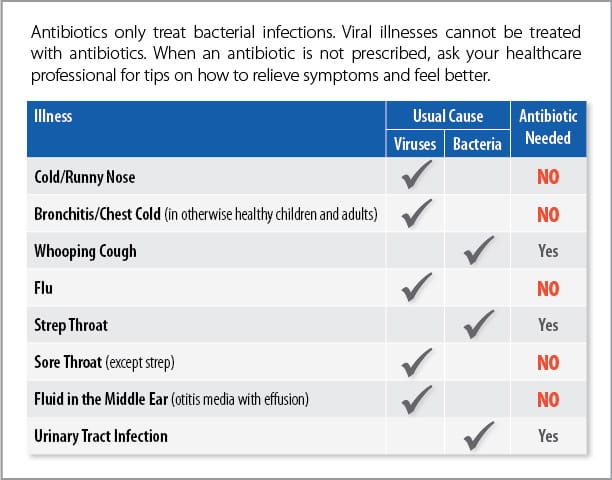November 30, 2016
Antibiotics are not for all illnesses
When you or your child is not feeling well, the impulse to get a prescription for an antibiotic – quickly! – seems like the best course of action, offering the most immediate relief for illnesses. Many of us have grown up believing antibiotics are a “cure-all,” having experienced success when using them in the past. But, depending upon what ails you, an antibiotic may not be the proper course of treatment. Or it may even do more harm than good.
 Antibiotics can only treat illnesses caused by bacteria. Colds, the flu, most sore throats, bronchitis, and many sinus and ear infections are caused by viruses, not bacteria. If your child has a viral infection, for example, antibiotics won’t help them feel better or get well sooner.
Antibiotics can only treat illnesses caused by bacteria. Colds, the flu, most sore throats, bronchitis, and many sinus and ear infections are caused by viruses, not bacteria. If your child has a viral infection, for example, antibiotics won’t help them feel better or get well sooner.
Antibiotic Resistance
Antibiotic/antimicrobial resistance is the ability of microbes to adapt, evolve, and eventually resist the effects of medications – meaning, germs are not killed and their growth is not stopped.
Taking antibiotics when they are not needed is fueling an increase in drug-resistant bacteria, which cause infections that are more difficult, and sometimes even impossible, to cure.
According to the Centers for Disease Control and Prevention (CDC), almost all types of bacteria have become less responsive to antibiotic treatment. These “superbugs” can quickly spread to family members, schoolmates, and coworkers, and threaten our communities with illnesses that were once easily treatable.
The CDC reinforces the message that using antibiotics is the single most important factor leading to antibiotic resistance around the world – and simply using antibiotics creates resistance. Combatting antibiotic resistance is a priority for the CDC with estimates of more than 2 million resistant infections occurring annually in the United States alone.
What you can do
Limiting your use of antibiotics and avoiding taking them when it’s not really necessary is the best way to prevent antibiotic resistance. Here are some suggested guidelines to follow:
- Don’t take an antibiotic for a virus.
- Don’t save an antibiotic for the next time you get sick.
- Take antibiotics exactly as prescribed. Don’t skip doses. Complete your full course of treatment even if you are feeling better.
- Never take an antibiotic prescribed for someone else.
If your physician has ruled out a bacterial infection as the cause of your illness, there are a number of options available for making symptoms of a viral infection more tolerable, even for children. Your doctor can suggest the best remedies to try, but the CDC also offers some helpful guidelines to follow on the following webpage: Symptom Relief
For more information about the right way to use antibiotics, visit www.cdc.gov/getsmart.
